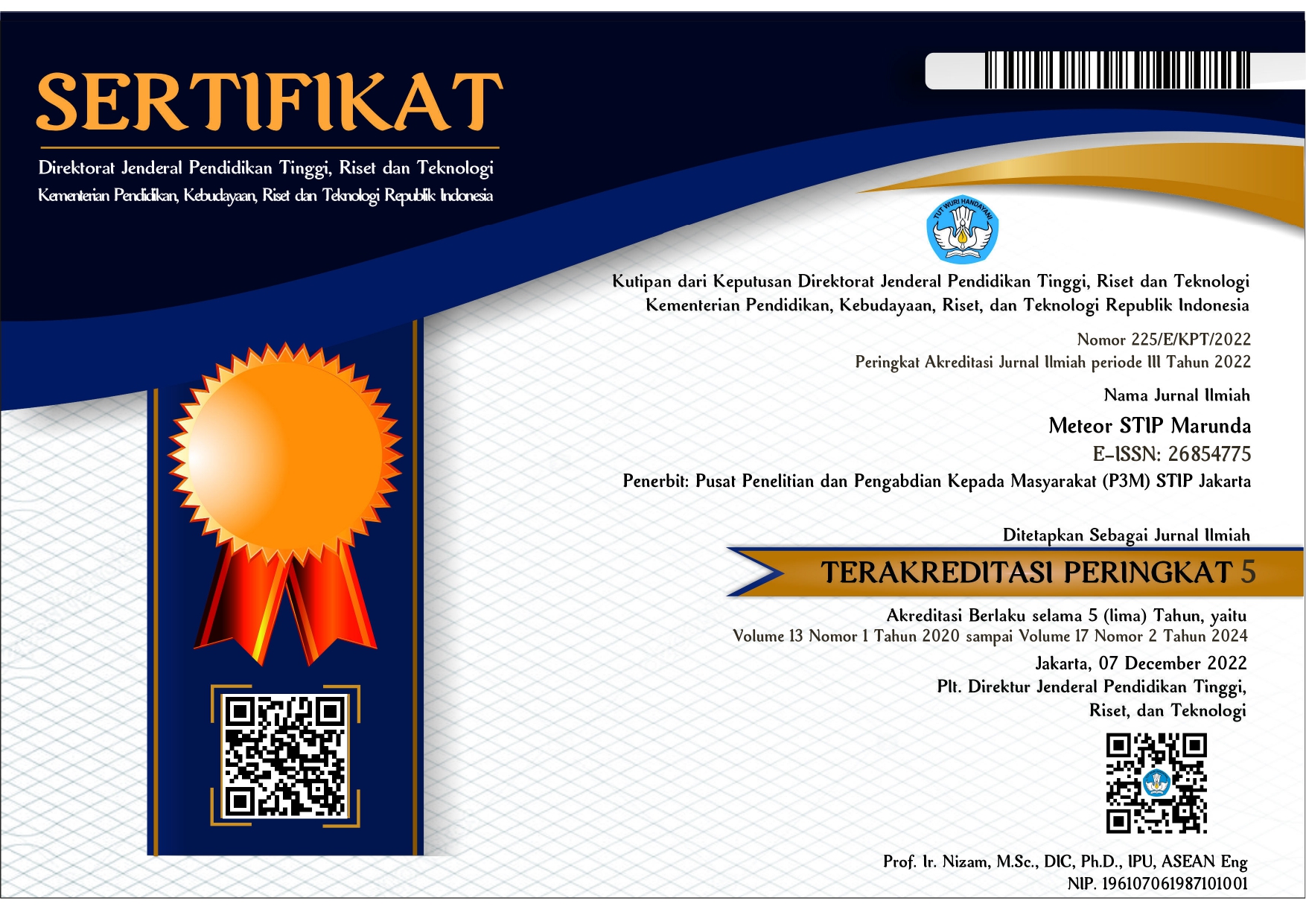THE IMPACT OF ECOPORT SOCIALIZATION AND PORT WASTE MANAGEMENT SYSTEM ON GREENPORT IMPLEMENTATION
Abstract
Port Waste Management System (PWMS) is a comprehensive waste management approach employed at ports to mitigate environmental harm. PWMS encompasses the collection, segregation, and disposal of various types of waste generated at ports, including solid, liquid, and hazardous waste. Through the adoption of sustainable technologies such as renewable energy and efficient water management, ports can significantly reduce their carbon footprint and ecological impact. Ecoport and Port Waste Management System advocate for sustainable practices within port operations. This study aims to assess the influence of the Ecoport Socialization Program on Greenport implementation at Tanjung Priok Port, aiming to enhance awareness regarding the importance of minimizing environmental impact and improving resource efficiency within the port sector. The findings indicate a positive and statistically significant relationship between the Port Waste Management System (X2) and Greenport Implementation (Y), with a coefficient value (Original Sample column) of 0.579 and P-Values of 0.000 < 0.05. Furthermore, the Q-Square (Q2) value for Greenport Implementation (Y) is 0.465, indicating that Ecoport Socialization (X1) and Port Waste Management System (X2) possess predictive relevance for Greenport Implementation (Y). Combined, Ecoport Socialization (X1) and Port Waste Management System (X2) account for 59.6% of the variance in Greenport Implementation (Y), with the remaining 40.4% attributable to other factors. In conclusion, this study demonstrates that Ecoport socialization and Port Waste Management System significantly contribute to explaining Greenport Implementation.
References
Abdul Khalid, S. N., & Musa, Z. (2020). The implementation of Green Port Policy in Malaysia: Challenges and strategies. Transportation Research Procedia
Akmalia, R., & Syukur, M. (2018). A Review of Port Waste Management System in Indonesia. Journal of Marine and Aquatic Sciences
Alexander Purba (2022). Green Port: A Must for International Ports Towards HUB PORT, Engineering Journal Vol. 14 No. 2, accessed on July 2.
Banwell, E., Hanley, T., Sefi, A. (2022). Quantitative Practice-Based Research. In: Bager-Charleson, S., McBeath, A. (eds) Supporting Research in Counselling and Psychotherapy. Palgrave Macmillan, Cham.
Berg, H. P. (2013). Human factors and safety culture in maritime safety. Marine Navigation and Safety of Sea Transportation: STCW, Maritime Education and Training (MET), Human Resources and Crew Manning, Maritime Policy, Logistics and Economic Matters, 107, 107–115.
De Langen, P.W., Woxenius, J., & Heaver, T. (2017). The Port Authority in a Changing Port Industry: A Review. Maritime Economics & Logistics, 19(1), 1-21. doi:10.1057/mel.2016.1
Edy Hidayat (2022). Port Planning, Design and Development. Port Reference Series 03 Edition II. Jakarta: PT Pelabuhan, Indonesia I, II, III, IV.2009, accented July 2.
Ferreira, P., Magalhães, S., & Caldeirinha, V. (2020). Waste management performance of Portuguese ports: A data envelopment analysis approach. Maritime Policy & Management
Figueroa, R.M., Saitua, M.T., & Gualda, N. (2020). Exploring the relationship between green port initiatives and seaport waste management practices: The case of Chilean ports. Marine Policy
Fontana, M., & Salzano, E. (2021). The management of port waste: A review and analysis of international regulatory frameworks. Waste Management & Research
González-Torre, P., Marín-García, J.A., & Smith, N. (2020). A decision support system for port waste management: Case study in a Spanish port. Environmental Science and Pollution Research, 27(14), 15759-15770.
Hair, J., Ringle, C. and Sarstedt (2011). M. PLS-SEM: Indeed a Silver Bullet. Journal of Marketing Theory and Practice, 19.
Heslop, S., & Lu, J. (2017). Sustainability indicators for port cities: a comparative study of the Asian and European perspectives. Maritime Policy & Management, 44(5), 609-627.
IMO (International Maritime Organization) (2012). Guidelines for the Development of a National Port Reception Facility Strategy.
IMO, S. C. E. (2018). IMO. London.
International Association of Ports and Harbors (IAPH). Environmental Ship Index Guidelines for Ports. EcoPorts Toolkit.
International Association of Ports and Harbors (IAPH) (2020). Port Sustainability Handbook.
Islam, M.M., Mitra, A.K. (2024). Population Projection. In: Mitra, A.K. (eds) Statistical Approaches for Epidemiology. Springer, Cham. https://doi.org/10.1007/978-3-031-41784-9_13
Kurilla, R. (2023). Communication and Observation. In: Group Identity Fabrication Theory. Palgrave Macmillan, Wiesbaden. https://doi.org/10.1007/978-3-658-39967-2_2
Ong, T.S., Lee, A.S., Latif, B. et al. (2023). Enabling green shared vision: linking environmental strategic focus and environmental performance through ISO 14001 and technological capabilities. Environ Sci Pollut Res 30, 31711-31726. https://doi.org/10.1007/s11356-022-24280-2
Sarstedt, M., Moisescu, OI.(2024). Quantifying uncertainty in PLS-SEM-based mediation analyses. J Market Anal 12, 87-96. https://doi.org/10.1057/s41270-023-00231-9
Verschuur, J., Koks, E. E., & Hall, J. W. (2021). Global economic impacts of COVID-19 lockdown measures stand out in high-frequency shipping data. PLOS ONE, 16(4), e0248818. https://doi.org/10.1371/journal.pone.0248818












_(1)(1).png)

